Gap Year Programs in Australia
About
Although Australia may be better known for sending its youth away on gap year adventures throughout the globe, Australia has also long been a popular gap year destination for gappers.
In addition to having a fantastic working holiday visa that allows citizens of several countries to work legally in the country, 'Straya is full of natural wonders and lively cities.
But whether you're trying to break into the travel world, work an international gig, or want a vast expanse of land to roam, a gap year in Australia is sure to meet your travel goals.
Types of Programs
From its beaches, deserts, "the bush," and "the Outback" to the cosmopolitan attractions of its large cities, you'll have so much to see -- too much, in fact! -- while on a gap year in Australia. Not to mention, the overall safety, ease of travel, and friendly Aussie locals make it an ideal location for newbie travelers and first-time solo travelers. Here are a few popular gap year programs that are available in Australia:
Working Holiday
Perhaps one of Australia's biggest draws for gappers is the opportunity to live and work legally in the country on a working holiday visa. Available to youth ages 18 - 31 (you must not have turned 31 by the time you apply for the visa), the Australian working holiday visa will allow foreign nationals from several countries (yes, even Americans!) to work for up to six months at a job (or two -- you have a full year).
Typically, these gap year jobs are in service/retail, tourism, or agriculture industries. Work as a barista, hostel receptionist, or picking grapes -- whatever meets your fancy.
Volunteering
If you want to get more involved with real Australia, try volunteer work during your gap year. Link up with fun and rewarding wildlife conservation projects in the rainforest of North Queensland, work with the elderly, tutor, or join a local gardening project. You can also volunteer with local charities and NGO’s in Australia such as Friends of the Earth or Greenpeace Australia Pacific.
Traveling
Traveling around Australia is one of the best things to do, especially if you have a whole year to experience this enormous country. Australia is the smallest continent but the sixth-largest country. It’s as large as 48 contiguous United States. Australia is highly urbanized; most of the population is heavily concentrated along the Eastern and Southeastern coasts, but the distance between cities and towns is easy to underestimate.
Melbourne boasts the largest tram network of any city globally, but most of Australia is not easy to travel through. Buses cover more of Australia’s rural landscape than trains, but traveling off the beaten path may require a few days’ wait. If you want to see large parts of Australia, you’ll most often have to take domestic flights throughout the country.
Adventure Travel
For the adventurers at heart, Australia offers plenty of fun activities to occupy your gap year. You can learn how to scuba dive off the coast of King Island, contemplate art at the MONA (The Museum of Old & New Art) in Tasmania, or lose yourself on a road trip through the natural splendor of the Outback. Australia offers something for everyone.
Internships
Make your resume stand out! An internship in Australia provides unique experience that will differentiate your CV. International experience is sought after in today's market, and undertaking an internship in Australia offers interns the opportunity to show employers that they’re flexible and confident when working in a new environment. If you don’t want to be tied down during your gap year, many internships are as short as 6-10 weeks and allow you to customize your internship if you’re a student. Many internships offer academic credit as well.
Planning Your Trip
Alright, so you're committed to taking a gap year down under, what should you know about planning your trip?
Cost of Living During a Gap Year in Australia
Living in Australia is similar to living in the U.S., with certain items being cheaper and others being more expensive. While youth hostels and inexpensive dorm accommodations are common throughout the cities, Australian currency, also called the dollar, is essentially equal to the USD. If you're a budget traveler, $2,000 - $2,500 will be enough to live comfortably in most Australian cities. Of course, global cities like Sydney and Melbourne tend to have higher rent and food costs than others.
You can offset gap year costs of living in Australia by working on a working holiday visa. Though the cost of living is generally much higher than the U.S., so is their minimum wage (over $20).
Also, try to avoid buying high-end electronics in Australia -- they're all imported and much more expensive than in North America or Europe.
Health and Safety in Australia
Exposure to the sun at Australian latitudes frequently results in sunburn. Getting sunburned can make you feel feverish and unwell, taking a few days or even weeks to heal. You can burn in as little as 15 minutes during the Australian summer. You should wear sunscreen (SPF 30+), clothing, and a hat to shade the sun.
Australia's cleanliness standards are high. Restaurants are required to observe strict food preparation regulations. Carrying water on hot days is a good idea in urban areas, and it is a necessity if hiking or driving out of town.
Australia does not have endemic diseases that will require non-standard vaccinations. Like many other countries, it will require evidence of yellow fever and other vaccinations upon entry.
Popular Cities
Australia is a massive country, and despite its size, it's packed to the absolute brim with fun and exciting travel adventures for every type of gapper. Whether you want to chill out, get some work experience, volunteer, or kick it in the outback, these are the spots you shouldn't miss out on!
Sydney
There's a special feeling associated with stepping off a plane or bus and entering the city of the famed Sydney Opera House! The view across Sydney Harbour will take your breath away. As you experience the city be sure to take some time out and visit the Blue Mountains; with stunning scenery all around you, you’ll begin to appreciate the true beauty that Australia has to offer.
Take a trip to the famous Bondi Beach, but don’t spend all day there! Instead, walk the Pacific Trail, which takes you along the coast and introduces you to some of the best beaches in the world. You will end your walk on Coogee Beach, a stunning and less packed beach than Bondi.
Melbourne
If you head west from Sydney, you'll reach Melbourne. Melbourne is a laid-back city that contrasts Sydney's fervor. Melbourne perfectly combines sophisticated arts and culture with beatnik charm, all nestled in amazing architecture. Melbourne's streets are sprinkled with art galleries, cafés, farmers markets, and specialty shops, and the downtown area is home to a thriving international business community.
Rent a car in Melbourne and drive along the Great Ocean Road to your next stop: the 12 Apostles. The views along this drive are magnificent, and there is no shortage of stunning rock formations that dot the coast.
Adelaide
Home to some of the world's best steak houses, Adelaide is a little city lacking the hectic pace that Sydney and Melbourne offer. Relax for an afternoon in one of the many green parks that surround the centre or eat locally-grown cherries on the beach. Adelaide will make for a great place to relax and decompress from the buzz of other Australian cities.
Perth
Situated along the Swan River, Perth is the pinnacle of a picturesque city. Check out Kings Park to get extraordinary views and relish the wildlife of the Botanic Garden. Kings Park is even larger than New York's Central Park, so feel free to literally "get lost!"
With its quaint cobbled streets, small street cafés, and creative atmosphere, Perth has a strong European vibe. Another activity unique to Perth can be found at Fremantle Prison. Learn of the history in this place, originally built as a convict barracks in the 19th century.
Darwin
Darwin differentiates itself from other Aussie cities due to its stark Asian influences and the legacies of WWII. The compact size of Darwin's downtown business district makes it best explored on foot or bicycle -- expect great views over the harbor. Stop for lunch at a restaurant that specializes in local Northern Territory dishes such as mud crabs, barramundi, buffalo, kangaroo, and crocodile. Visiting Darwin is incomplete without a trip to the open-air Mindil Beach sunset markets.
Consider hopping to Litchfield National Park for a day to find the company of waterfalls and lush waterholes. You can even hit the trails in a 4WD!
Cairns
Dive into the World Heritage Great Barrier Reef, white water rafting on the Tully River, go bungee jumping, skydive; go horse riding, quad biking - seriously, this list is endless - you will want to spend some quality time here!
No matter if you are a non-swimmer, a snorkeling amateur, or a dive guru, there are plenty of Cairns activities for all water and landlubbers alike. It's best to visit Cairns in the dry season (May - October) to take full advantage of all it has to offer. Also, a great place to consider setting up a more permanent shop during your gap year in Australia.
Byron Bay
Byron Bay is famous for its beaches, its relaxed rainforest atmosphere, and its Bohemian lifestyle. As the easternmost point in Australia, Byron Bay is a haven for adventure and eco-travelers, lovingly dubbed "ecotopia" by locals and visitors alike. Take some time out to enjoy the views, have a go at your first surf lesson, and scout out the land and marine mammals alike (wallabies and flying foxes known to make frequent appearances!). If you’re lucky, you might spot some whales at Cape Byron.
Gap Year Programs in Australia
Pagination
New Jobs
View the latest job postings on our job board. A great way to earn work experience during your gap year!
Frequently Asked Questions
-
Do I need a visa to visit Queensland?
Whether you’re studying in Queensland or just taking a quick holiday, all visitors who are not from Australia will need a visa. If you’re visiting for tourism purposes, you will need to obtain an Australian Tourist visa.
-
What are some of the top things to do in Queensland?
Queensland offers plenty of exciting things to do for nature lovers, adventure seekers, and anyone just looking to disconnect and explore. You can visit the tropical waters of Whitsunday Islands, snorkel with the vibrant marine life in the Great Barrier Reef, or even take a safari through Daintree National Park, the world’s oldest living rainforest – there’s so much to do and see!
-
How much should you budget for a spring break in Queensland?
Spring, summer, and holidays tend to be the more expensive times to visit Queensland, as they’re peak tourist periods. Flights from the US to Brisbane can range anywhere from $500 - $1500 round trip. You should expect to spend around $100-$150 USD a day during your trip in Queensland, including food, accommodations, and any activities you do. However, if you’re on a tight budget, there are also fun affordable options such as hiking, visiting beaches, or exploring museums – many of which won’t even cost a dime if you’re a student!
-
What is Queensland known for?
Known as the “Sunshine State,” Queensland is famous for its golden beaches (hello white sand and clear blue water!), 5 World Heritage-listed sites including the Great Barrier Reef and the planet’s oldest living rainforest, and much more, making it a fantastic spring break destination.
-
What kind of visa do I need for a gap year in Australia?
The first step in planning your gap year in Australia is to check your visa eligibility to ensure you can legally stay in the country for an extended period. The most common visa for gappers in Australia is the working holiday visa, which permits both work and travel within Australia for the one year it is valid. You can research your eligibility and apply through the Australian Border Force website.
-
How much does a gap year in Australia cost?
The cost of a gap year in Australia will vary greatly depending on what you plan to do. Gappers who au pair or partake in a work exchange program like WWOOFing can offset living expenses and only incur airfare and personal expenditures. In some cases, you may even get paid a stipend for this work. Travelers who choose to go to Australia through a gap year program should expect to spend as much as USD 5,000 or more for the program itself. The overall cost of living in Australia is similar to the US, which should be accounted for in your budget on top of program and transportation expenses.
-
What are the most popular types of gap year programs in Australia?
Australia is a popular gap year destination for travelers looking to split their time between short-term employment and adventurous activities, including surfing, scuba diving, and sailing. Additionally, au pair work exchanges, volunteering with environmental conservation projects, and paid farm work are all popular options for a gap experience in Australia.
-
Can I stay in Australia after graduation?
The length of time you can stay in Australia after you graduate depends on the type of degree you received. You will need to apply for a 485 skilled graduate temporary visa so that you can stay in the country for work, travel, or to continue your studies. You can stay for an additional 2 years after graduation if you received a bachelor's degree, master's degree, or master's by coursework degree. You can stay for 3 additional years if you received a master's by research degree. And you can stay for 4 years if you received a PhD.




















